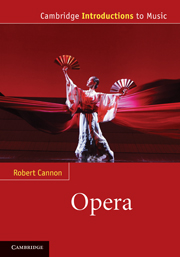Book contents
- Frontmatter
- Contents
- Tables
- Introduction
- Part I The seventeenth and eighteenth centuries
- Chapter 1 Pre-operatic forms
- Chapter 2 First operatic forms
- Chapter 3 Formalisation
- Chapter 4 Reform: the reintegration of elements
- Chapter 5 Comedy and the ‘real world’
- Chapter 6 Authentic performance
- Part II The nineteenth century
- Part III The twentieth and twenty-first centuries
- Appendix 1 Motifs from The Ring used in Chapter 10
- Appendix 2 The development of singing voices in opera
- Appendix 3 The development of lyric theatre alternatives to ‘opera’
- Appendix 4 Some major operas and artistic and political events of the twentieth century, 1899--2008
- Glossary of key terms
- Notes
- Bibliography
- Index
Chapter 3 - Formalisation
from Part I - The seventeenth and eighteenth centuries
Published online by Cambridge University Press: 05 June 2012
- Frontmatter
- Contents
- Tables
- Introduction
- Part I The seventeenth and eighteenth centuries
- Chapter 1 Pre-operatic forms
- Chapter 2 First operatic forms
- Chapter 3 Formalisation
- Chapter 4 Reform: the reintegration of elements
- Chapter 5 Comedy and the ‘real world’
- Chapter 6 Authentic performance
- Part II The nineteenth century
- Part III The twentieth and twenty-first centuries
- Appendix 1 Motifs from The Ring used in Chapter 10
- Appendix 2 The development of singing voices in opera
- Appendix 3 The development of lyric theatre alternatives to ‘opera’
- Appendix 4 Some major operas and artistic and political events of the twentieth century, 1899--2008
- Glossary of key terms
- Notes
- Bibliography
- Index
Summary
By the middle of the seventeenth century opera had established itself, moving between the worlds of the commercial, popular opera of Venice or Hamburg and that of the court. The commercial world enjoyed the mixed genre combining comedy and tragedy, a growing star system and a developing audience. By contrast, the courtly world continued to demand classically based plots, high moral purpose and restraint. Musically, too, a series of tensions developed as the attractions of the melodious aria increasingly relegated the monodic, diastematic writing of Peri and Caccini to those passages where information was needed to carry the action forward. Conversely, the aria increasingly became the centre of musical attention while its dramaturgical function contracted. As these two elements became more distinct, opera potentially became a mere vehicle for the aria. France alone withstood these tendencies, here opera continued to develop as a genuinely dramatic form. The direct link between royal/state encouragement of the arts and their centralised control, was established through the Académies. These were designed to ensure that the arts fulfilled their role in enhancing the nation's prestige. From 1661 onwards Louis XIV embarked on a series of military and diplomatic offensives that gave France a leading role in the political life of Europe. The success of the monarchy, its brilliant display in the arts and its Europe-wide political authority, made the king the paradigm for rulers and France their cultural model.
Towards opera seria: first stage – Apostolo Zeno
Significantly, the Italian return to the original seriousness of opera was inspired by French criticism, and the initial response came from writers. The result was the codification of opera and a formalisation of its elements, including the music, which established the dominant form of the late seventeenth and eighteenth centuries, the opera seria (serious opera). Opera was to be ‘cleansed’ of the comedy, mangled adaptations of the classics and wilful scenic excesses of works such as Giasone and Croesus.
- Type
- Chapter
- Information
- Opera , pp. 33 - 49Publisher: Cambridge University PressPrint publication year: 2012

